Even in the chilly winter, one of my favorite dishes to prepare is Korean icy cold noodles (naengmyeon: ).
I can’t resist the texture of the chewy and thin noodles, no matter if they are served with cold broth (mul-naengmyeon: 물냉면) or in a spicy sauce (bibim-naengmyeon: 비빔냉면). Especially on hot summer days like these, I really feel my body cools right down after I slurp the cold noodles and drink the leftover cold icy broth. The cold broth is tangy, savory, and a little sweet and the noodles are soft but chewy at the same time.
Today I’m going to show you how to make mul-naengmyeon, icy cold noodles in a chilled broth. Traditionally the broth is made from the brine of fermented radish water kimchi (dongchimi: 동치미) and beef stock, and if you’ve been following me for a long time, you know that I made a naengmyeon video years ago, and also included traditional mul-naengmyeon in my cookbook. They both have different recipes for the broth and I’ll include them below, at the end, if you want to see them.
Today’s mul-naengmyeon recipe is a more user-friendly version. I don’t make my own broth from scratch, but instead use the concentrated broth powder or liquid that comes with the naengmyeon noodles package (Amazon link) as a base. Then I add some pear juice and some sweet and sour cucumber pickle brine to enhance the taste.
I often make this easy mul-naengmyeon these days. It’s so simple and in my opinion it tastes much better than mul-naengmyeon in a restaurant. You can try it out and let me know what you think!
Ingredients
Serves 2
- 10 ounces (280 grams) dried naengmyeon noodles
- 2 packets of liquid or powdered concentrated broth that comes with the package of naengmyeon noodles
- 2 packets of mustard oil that comes with the package of naengmyeon noodles.
- ½ English cucumber, cut into thin strips
- 1 Korean pear (or 2 bosc pears)
- ½ teaspoon kosher salt
- 1½ teaspoon sugar
- 1 tablespoon white or apple cider vinegar
- 1 hard-boiled egg, cut in halves
- 2 tablespoons toasted sesame seeds, ground
- ice cubes
Make broth
- Open the packets of the concentrated broth and put them into a bowl. Mix with 4 cups of water.
- Keep in the freezer for 4 to 5 hours so it gets slushy.
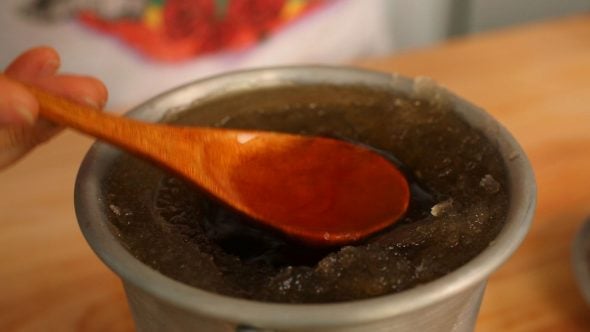
- If you can’t make the broth in advance, make the broth with only 2 cups of water and add 2½ cups of ice cubes. Keep it in the fridge while you prepare everything else, and take it out just when you’re ready to serve.
Prepare cucumber and pear garnishes
- Make quick pickled cucumbers by combining the sliced cucumber, kosher salt, ½ teaspoon sugar, and vinegar in a bowl. Mix it well and set aside.
- Make sugar water by mixing 1 cup of water and 1 teaspoon sugar.
- Peel the pear and slice into halves. Slice one half into thin strips and soak them in the sugar water to keep them from going brown.
- Grate the other half of the pear and squeeze out the juice using a cotton cloth or cheesecloth. You should get about ½ cup of pear juice. If you use small bosc pears, use one for garnish and the other for pear juice.
- Take the bowl of broth out of the freezer. Squeeze some cucumber brine into the broth and add the pear juice.
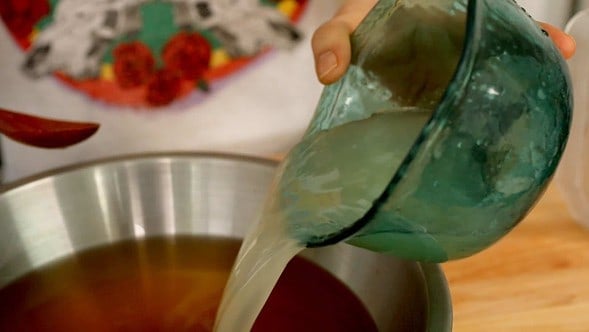
- Mix well and put the broth back in the fridge or freezer until the noodles are ready.
Prepare noodles
- Bring a large pot of water to a boil. Add the noodles and stir with a wooden spoon. Cover and let them cook for 3 to 5 minutes.
- Take a sample to taste. When you chew the noodles, there shouldn’t be any hard stuff inside. Be sure not to overcook them or they’ll go soggy.
- Strain and rinse the noodles in cold running water until they aren’t slippery any more and are well cooled.
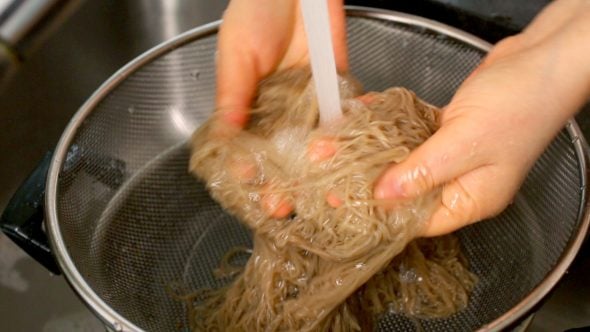
- Fill a large bowl with cold water and some ice cubes. Add the noodles and rinse them a final time.
- Drain the noodles and divide them into 2 large shallow bowls.
Put it together
- Pour the icy broth into each bowl.
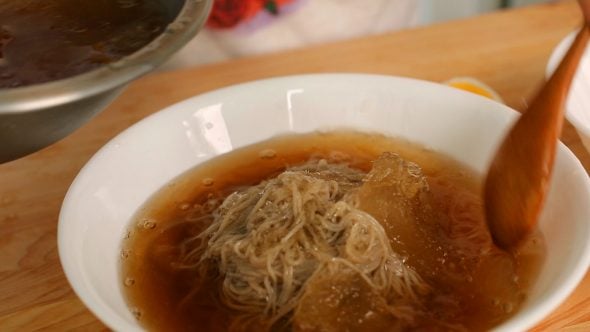
- Place the cucumber and pear on top.
- Add a packet of mustard oil to each bowl.
- Sprinkle with some sesame seeds powder. Add a half egg on top of each bowl.
- Serve right away.
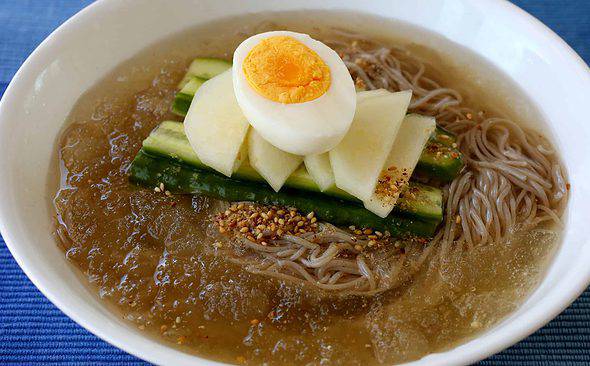
Variation: Anchovy, mushroom, & kelp stock broth
If you have more time, anchovy stock broth is a more delicious and savory option than using the packets that come with the noodles. This is the kind of broth I made in my original naengmyeon video, years ago. I didn’t show the exact process in the video, but it’s pretty easy:
Ingredients
- 8 cups of water
- 3 or 4 shiitake mushrooms
- 4 inch piece of dried kelp
- 8 to 10 dried anchovies (with the heads and the intestines removed)
Directions
- Boil 8 cups of water with all ingredients for 20 minutes over high heat.
- Lower the heat and cook another 20 minutes. Strain, cool it down and put it in the freezer.
Mustard paste
In the video I also make a homemade mustard paste by mixing 1 tbs of mustard powder and ½ tbs water, and then setting it in a warm place for 5 minutes for it to ferment (in the video, it’s on the top of the pot!).

Traditional broth: dongchimi & beef stock
This is the most delicious, tangy, beefy, unique tasting broth you will ever have, but it also takes the longest to make, because dongchimi itself needs at least 4 to 5 days to ferment.
Even though it takes a lot of effort, the taste is unbeatable and much better than you can get any other way. This recipe is from my book, Maangchi’s Real Korean Cooking.
Ingredients
- 8 ounces beef brisket
- 7 cups water
- 4 cups brine from dongchimi
- 2 teaspoons kosher salt
- ¼ cup sugar
Directions
- Rinse the brisket under cold running water, then soak in a bowl of cold water for 10 minutes to remove any blood, so you get a nice, clear broth.
- Bring the 7 cups water to a boil in a pot over high heat. Drain the brisket and add to the pot. Turn the heat down to medium and cook, covered, for 1 hour.
- Turn the heat down to low and cook for another 50 minutes.
- Take out the brisket and set the broth aside to cool.
- Thinly slice the beef. Cover and refrigerate.
- Combine the beef broth and kimchi brine in a freezer safe bowl. Add the salt and sugar and stir to dissolve. Cover and put into the freezer.
Serving
- Later, when you serve your mul-naengmyeon, use the slices of beef as a garnish, along with the cucumber, pear, and egg. You can also add some thin slices of dongchimi if you have it.
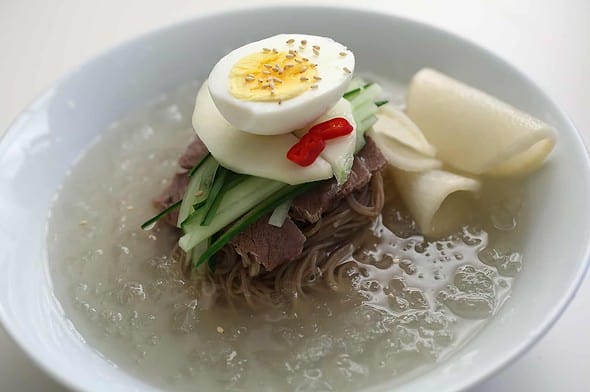
Source: https://www.maangchi.com








